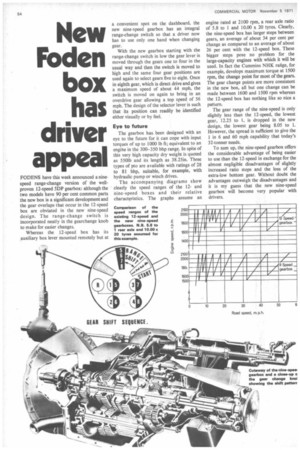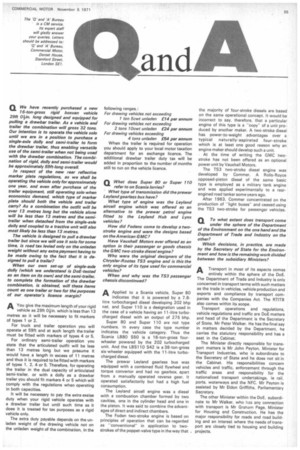New Foden box has driver appeal
Page 56

Page 57

If you've noticed an error in this article please click here to report it so we can fix it.
FODENS have this week announced a ninespeed range-change version Of the wellproven 12-speed 5DP gearbox: although the two models have 90 per cent common parts the new box is a significant development and the gear overlaps that occur in the 12-speed box are obviated in the new nine-speed design. The range-change switch is incorporated neatly in the gearchange knob to make for easier changes.
Whereas the I2-speed box has its auxiliary box lever mounted remotely but at a convenient spot on the dashboard, the new nine-speed gearbox has an integral range-change switch so that a driver now has to use only one hand when changing gear.
With the new gearbox starting with the range-change switch in low the gear lever is moved through the gears one to four in the usual way and then the switch is moved to high and the same four gear positions are used again to select gears five to eight. Once in eighth gear, which is direct drive and gives a maximum speed of about 44 mph, the switch is moved on again to bring in an overdrive gear allowing a top speed of 56 mph. The design of the selector lever is such that its position can readily be identified either visually or by feel.
Eye to future The gearbox has. been designed with an eye to the future for it can cope with input torques of up to 1000 lb ft; equivalent to an engine in the 300-350 bhp range. In spite of this very high capacity dry weight is quoted as 5501b and its length as 38.25in. Three types of pto are available with ratings of 28 to 81 bhp, suitable, for example, with hydraulic pump or winch drives.
The accompanying diagrams show clearly the speed ranges of the 12and nine-speed boxes and their relative characteristics. The graphs assume an
42 We have recently purchased a new 16-ton-gross rigid box van vehicle 29ft Olin. long designed and equipped for pulling a drawbar trailer. As a vehicle and trailer the combination will gross 32 tons. Our intention is to operate the vehicle solo until we are in a position to purchase a single-axle dolly and semi-trailer to form the drawbar trailer, thus enabling versatile use of the semi-trailer when not being used with the drawbar combination. The combination of rigid, dolly and semi-trailer would be approximately 59ft-long overall.
In respect of the new rear reflective marker plate regulations, as we shall be operating the vehicle only for approximately one year, and even after purchase of the trailer equipment, still operating solo when economics demand, which type of marker plate should both the vehicle and trailer carry? As a combination the outfit will be over 13 metres long but the vehicle alone will be less than 13 metres and the semitrailer when detached from the single-axle dolly and coupled to a tractive unit will also most likely be less than 13 metres.
The vehicle is designed to pull a drawbar trailer but since we will use it solo for some time, is road tax levied only on the unladen weight without any extra payment having to be made owing to the fact that it is designed to pull a trailer?
When our own set-up of single-axle dolly (which we understand is DoE-tested as an item on its own) and the semi-trailer, to complete the formation of the drawbar combination, is obtained, will these items count as one trailer or two for the purposes of our operator's licence margin?
AYou give the maximum length of your rigid
vehicle as 29ft Olin. which is less than 13 metres so it will be necessary to fit markers of types 1 or 2.
For truck and trailer operation you will operate at 59ft and at such length the trailer must be fitted with markers of types 4 or 5.
For ordinary semi-trailer operation you state that the articulated outfit will be less than 13 metres long but we presume it would have a length in excess of 11 metres and thus it is required to befitted with markers of types 1. 2, 4 or 5. Therefore, for operating the trailer in the dual capacity of articulated semi-trailer, or with a dolly as a drawbar trailer you should fit markers 4 or 5 which will comply with the regulations when operating in both capacities.
It will be necessary to pay the extra excise duty when your rigid vehicle operates with a drawbar trailer but until such time as it does it is treated for tax purposes as a rigid vehicle only.
The extra duty payable depends on the unladen weight of the drawing vehicle not on the unladen weight of the combination, in the following ranges.: For drawing vehicles not exceeding
1 ton 5cwt unladen L'14 per annum For drawing vehicles not exceeding 2 tons 10cwt unladen £24 per annum For drawing vehicles exceeding 4 tons unladen £54 per annum
When the trailer is required for operation you should apply to your local motor taxation department for an exchange licence. The additional drawbar trailer duty tax will be added in proportion to the number of months still to run on the vehicle licence.




































































































































































